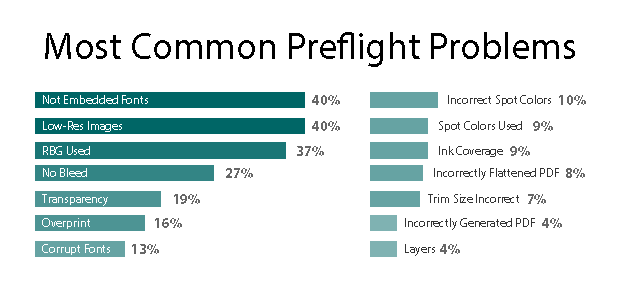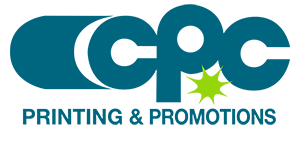Are These The Same Thing, OR: Who Checks What?
Sometimes, when we have a job in-house for printing, questions arise about proofing and preflighting. Are these the same thing? Does the printer “proofread” customer-supplied files? What, exactly, is checked during preflight?
Let’s tackle the questions one-by-one. First, proofing and preflighting are NOT the same process. Generally speaking, proofreading refers to the process of checking text for typos, misspellings and grammatical errors. The term “proofing” is sometimes used interchangeably with “proofreading,” but can also refer to the process of looking at a job for design problems such as misaligned slug lines, photos that overlap text, etc.
By the time we receive a file, it’s assumed that the customer has thoroughly proofread the job for text errors as well as proofed it for layout problems.
Which brings us to preflighting, which is done by our prepress department. It’s the process of examining a file for the purpose of locating and identifying any technical issues which could potentially cause problems with the actual printing of the job.
This process does NOT include proofing or proofreading files for typos or design mistakes. Occasionally a prepress technician will notice this kind of error during a preflight and mention it in the preflight report as a courtesy. This does not mean, however, that we have actually proofread or proofed the job; that is solely the customer’s responsibility.

So what does get checked during Preflight?
Here’s a general list, but keep in mind that every job is unique, so not everything on this list will apply to all jobs.
- Trim size: does the provided file size match the quote?
- Are crop marks offset enough? Or are they too close to the corners or even touching? (Too close or touching is a problem because they can show up in the image area of the finished piece and will also diminish the bleed.)
- Are pages in sequential order (correct) or readers or printers spreads? (incorrect)
- Is the bleed at least .25 inches on each edge? Our minimum is .125. Bleed needs to be larger if file has to be reduced.
- Is there a solid .25 inch margin/image area all the way around that’s free of critical text and graphics, including page numbers and/or slug lines?
- Does the page count of the file match the quote?
- If it drills, is the inside margin large enough to allow for that?
- If there are coupons or mailing cards, do they back up correctly?
- If it’s a brochure or other folded piece, are the panels correct?
- If it perfect binds, is the cover built as a spread with a spine? If not, have all the components been supplied so we can build a correct cover file?
- Is the color mode correct? (Anything used for printed materials must be CMYK, not RGB.)
- Is the black text 100% black only or does it break down to 4-color? Black text cannot be 4-color.
- Is there thin or small text reversed out of 4-color backgrounds? These have the potential to fill in or get pinched off.
- Are there gutter jumps? Gutter jumps are images and/or text that cross the gutter (or fold) from a left page to a right page. Due to binding and printing requirements, especially with large page counts, gutter jumps may not look right in the finished piece.
- If a PDF is provided, are the fonts embedded? Files will fail at ripping if all fonts are not embedded.
- Is the total ink coverage 300% or less? Our ink limit is 300%. Images whose percentages for all 4 channels add up to more than 300% will have to be adjusted to reduce total ink coverage.
- Are there poor quality photos? We check for any images that have effective resolutions of less than 150 dpi.
- Any there any perfs or varnishes? Flood or knock-out varnishes we build at no charge. Spot varnishes are charged for by time.
- If it mails, is the mailing area large enough and in the correct place to meet postal regulations?
Some things that are not checked for during Preflight:
- Typos or grammatical errors.
- Text overflow or missing copy.
- Missing graphics or photos.
- Color in photos. We may mention that a photo seems unusually dark or light, but actual hue, value and tone are individual preferences and preflight does not evaluate color.
- The ultimate goal of this collaboration between customer and printer is to create files that will produce a final printed piece that meets the customer’s vision.
Have any other questions on what you need to check during proofing and preflighting? Please contact us.

